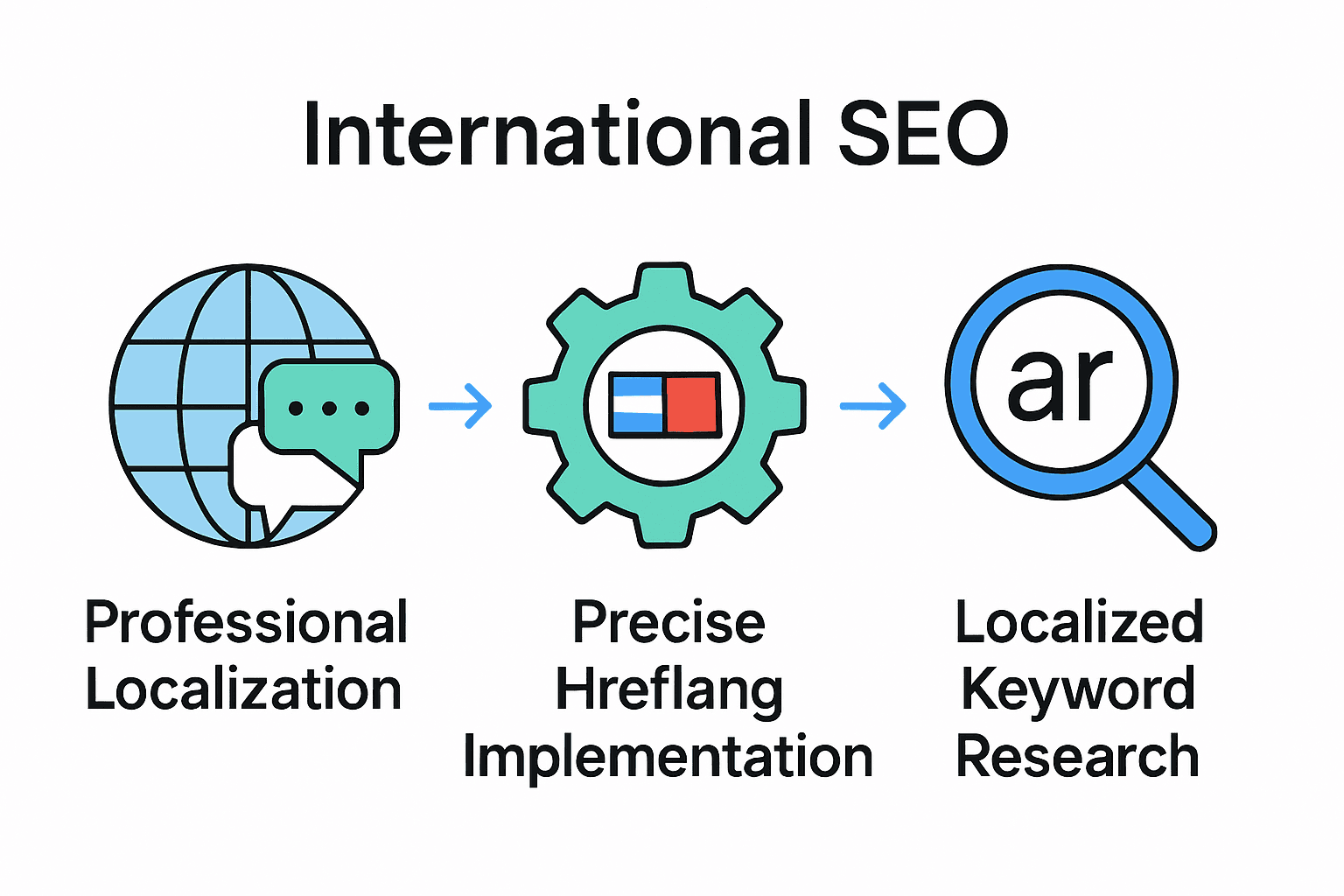Did you know that over sixty percent of global websites lose potential traffic due to poor international SEO practices? Expanding into new markets sounds simple, yet small mistakes in language and technical setup can hold your business back. Misconceptions about translation, cultural fit, and search optimization often lead to lost opportunities. Understanding the realities behind international SEO helps you reach new customers and build lasting connections across borders.
Key Takeaways
| Point | Details |
|---|---|
| Invest in Professional Localization | Automated translations are insufficient; businesses should ensure culturally resonant content through professional localization efforts. |
| Implement Precise Hreflang Tags | Effective hreflang implementation is critical to avoid duplicate content issues and ensure traffic is directed accurately. |
| Conduct Localized Keyword Research | Rely on localized keyword analysis tailored to each market instead of direct translations to optimize search engine relevance. |
| Understand Market Segmentation | Successful international strategies involve deep insights into cultural nuances and consumer behaviors beyond basic demographics. |
Table of Contents
- Defining International Seo And Common Myths
- Key Elements Of Multilingual And Multiregional Seo
- Implementing Hreflang And Technical Optimization
- Market Research And Target Audience Segmentation
- Risks, Common Pitfalls, And Best Practices
Defining International SEO and Common Myths
International SEO represents a strategic approach to optimising websites for multiple geographic regions and language markets, extending far beyond simple translation. It’s about creating targeted digital experiences that resonate with diverse global audiences while maintaining technical search engine compatibility.
One of the most prevalent myths in international SEO is believing automated translations will sufficiently localise content. According to research from Hike SEO, relying solely on machine translations can result in significant problems:
Here’s a comparison of common international SEO myths versus best practice realities:
| Myth | Reality |
|---|---|
| Automated translations are enough | Require professional localisation |
| One version suits all markets | Need market-specific content |
| SEO is only about translation | Involves technical and cultural factors |
| Basic hreflang tags suffice | Precise, region-specific configuration needed |
| Direct keyword translations work | Localised keyword research essential |
- Inaccurate linguistic nuances
- Culturally inappropriate messaging
- Reduced user engagement
- Potential search ranking penalties
Successful international SEO requires comprehensive strategies that go well beyond basic translation. Businesses must consider technical elements like hreflang implementation, which signals search engines about language and regional targeting. Improper hreflang configuration can lead to duplicate content issues and misdirected traffic, fundamentally undermining your global digital presence.
To truly excel in international markets, organisations need a nuanced approach that combines linguistic expertise, cultural understanding, and sophisticated technical SEO techniques. This means investing in professional localisation, understanding regional search behaviours, and developing content that authentically speaks to each target market’s unique preferences and expectations.
Key Elements of Multilingual and Multiregional SEO
Multilingual SEO demands a sophisticated approach that goes far beyond simple translation. According to research from Senna Labs, successful international digital strategies require intricate technical and cultural considerations to truly connect with diverse global audiences.
The foundational elements of effective multilingual SEO include:
- Localized Keyword Research: Conducting targeted keyword analysis specific to each language and regional market
- Hreflang Implementation: Precise technical signaling to search engines about language and geographic targeting
- URL Structure: Developing consistent, geo-targeted URL configurations that enhance indexing and user relevance

Research from DesignRush highlights critical technical components businesses must consider. These include translating metadata, creating dedicated regional URLs, and establishing robust multilingual analytics tracking systems.
Navigating multilingual SEO requires more than mechanical translation. It demands deep cultural understanding, nuanced linguistic adaptation, and technical precision. Organisations must invest in professional localisation that captures not just literal meaning, but cultural tone, regional search behaviours, and audience-specific communication preferences. This holistic approach ensures your digital presence genuinely resonates across different international markets.
Implementing Hreflang and Technical Optimization
Hreflang implementation represents a crucial technical strategy for international SEO, enabling precise language and regional targeting across global digital platforms. According to Search Engine Journal, effective multilingual website optimization requires strategic technical configurations that guide search engines and users seamlessly.
Key technical best practices for hreflang optimization include:
- Adding self-referential hreflang tags on all language variants
- Implementing x-default fallback for unspecified user regions
- Providing clear language navigation selectors
- Ensuring canonical URL alignment across different language versions
Research from Geneo emphasizes the importance of comprehensive technical strategies. This includes:
- Using dedicated URLs for each locale
- Maintaining comprehensive language-aware sitemaps
- Keeping structured data consistently language-aligned
Successful hreflang implementation goes beyond mere technical compliance. It’s about creating an intuitive, user-friendly international digital experience that signals to search engines the precise linguistic and geographic relevance of your content.
 Businesses must approach this as a holistic strategy, integrating technical precision with genuine user-centric design.
Businesses must approach this as a holistic strategy, integrating technical precision with genuine user-centric design.
Market Research and Target Audience Segmentation
International market segmentation represents a sophisticated approach to understanding diverse global audiences beyond traditional demographic categorizations. According to the VALS framework, effective audience targeting requires deep insights into consumer values, lifestyles, and psychological motivations that transcend geographic boundaries.
Successful international market research involves multiple strategic dimensions:
- Analyzing psychographic profiles
- Understanding cultural communication preferences
- Identifying region-specific consumer behaviors
- Mapping technological adoption rates
Cultural multivariate testing provides sophisticated methodologies for refining international digital strategies. By systematically experimenting with localized design elements—including imagery, navigation structures, and messaging—businesses can discover precise combinations that resonate most effectively with different market segments.
The goal of comprehensive market segmentation isn’t just data collection, but developing nuanced, empathetic understanding of how cultural contexts shape consumer interactions. This means moving beyond surface-level translations and creating genuinely localized experiences that reflect each market’s unique values, expectations, and communication norms. Sophisticated international brands recognize that true global engagement requires deep cultural intelligence and a willingness to adapt strategies dynamically.
Risks, Common Pitfalls, and Best Practices
International SEO strategies require meticulous planning and execution to avoid critical performance-undermining mistakes. According to research from Hike SEO, businesses frequently encounter significant challenges when expanding their digital presence across multiple markets.
Common multilingual SEO pitfalls include:
- Relying on direct keyword translations instead of localized research
- Improper hreflang implementation causing traffic routing errors
- Failing to update language tags during website expansions
- Neglecting language-specific backlink development
Research from Gulf Website Hub highlights the profound implications of these technical oversights. Direct translations without genuine localization can catastrophically reduce user engagement and search engine relevance, effectively rendering international expansion efforts ineffective.
Successful international SEO demands a holistic approach that goes far beyond mechanical translation. Organisations must invest in professional linguistic expertise, develop culturally nuanced content strategies, and maintain rigorous technical configurations. This means continuous monitoring, periodic content audits, and a commitment to understanding the unique digital ecosystems of each target market. The most effective international strategies treat each geographic region not as a translation challenge, but as a distinct digital environment requiring specialized, thoughtful optimization.
Ready to Make Your International SEO Work for Real Growth?
Struggling with the complex world of multilingual SEO, technical hreflang tags, or localised keyword research? You are not alone. Many business owners invest time and money into translation or generic SEO agencies that fail to deliver results overseas. This is why Business Warriors stands apart. We understand that international SEO demands more than just technical boxes ticked; it needs a tailored, omnichannel approach that speaks directly to your audience’s unique cultural and regional expectations. Our proven Marketing Vortex system fuses expert localisation, strategic SEO, and cross-platform advertising to attract clients and boost global visibility for service-based businesses just like yours.

Stop letting lost leads and ineffective translations hold you back from global success. Discover how our integrated strategies guarantee bookings, higher rankings, and measurable ROI across every target market. Head to Business Warriors | Digital Marketing Agency to see real client stories, learn how the Marketing Vortex Method gives you a real competitive edge, or reach out for a personalised consultation today. Take the first step towards leading your field internationally—visit https://jarrodharman.com now and start transforming your international marketing.
Frequently Asked Questions
What is International SEO?
International SEO is the practice of optimizing a website for multiple geographic regions and language markets to enhance its visibility and relevance in various global audiences.
Why is professional localization important for international SEO?
Professional localization is crucial because automated translations can lead to inaccuracies, culturally inappropriate messaging, and reduced user engagement. Localized content resonates better with target audiences.
How do hreflang tags benefit international SEO?
Hreflang tags signal to search engines the language and regional targeting of specific web pages, helping to prevent duplicate content issues and ensuring users see the most relevant version of a site based on their location and language.
What are some common pitfalls to avoid in international SEO?
Common pitfalls include relying on direct translations instead of localized keyword research, improper hreflang implementation, and neglecting the development of language-specific backlinks.
Recommended
- What is Search Optimisation? A Detailed Understanding – Jarrod Harman
- Master SEO for Hair Salon: Boost Your Online Visibility – Jarrod Harman
- Understanding the Advantages of Social Media Optimization – Jarrod Harman
- Effective Social Media Growth Strategy for Businesses – Jarrod Harman
- Mastering Hreflangs: Your Ultimate Guide to International SEO Success
- Understanding SEO Best Practices for Your Business – My Blog


